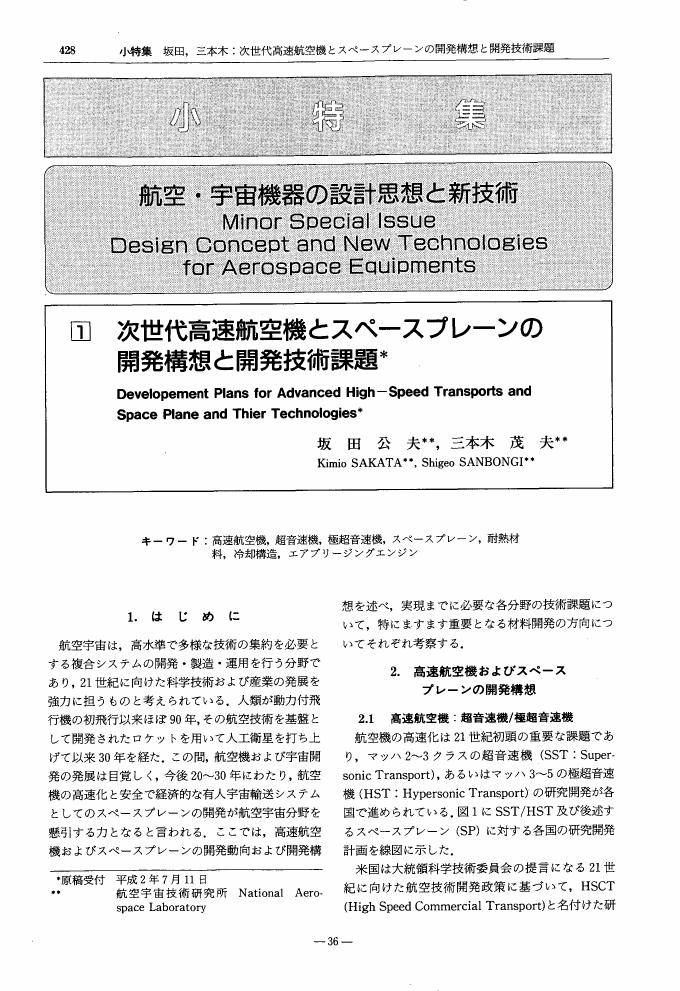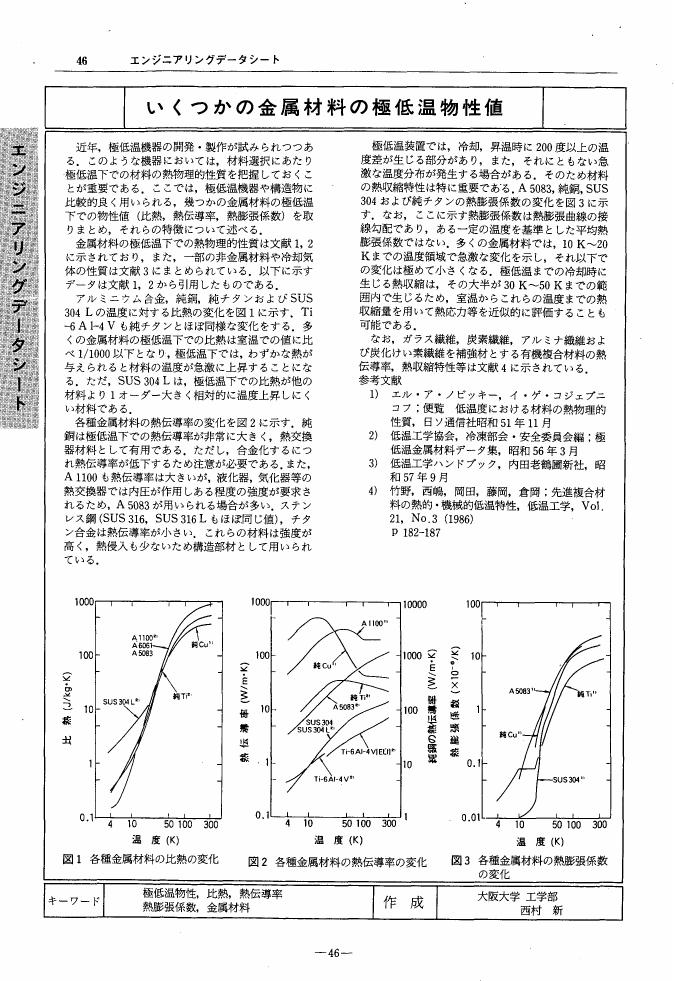1 0 0 0 OA 超小型試験片による局所材料強度特性評価 ―スポット溶接継手の強度予測への応用―
- 著者
- 中山 英介
- 出版者
- 一般社団法人 溶接学会
- 雑誌
- 溶接学会誌 (ISSN:00214787)
- 巻号頁・発行日
- vol.75, no.6, pp.461-465, 2006 (Released:2011-08-01)
- 参考文献数
- 4
- 被引用文献数
- 3 3
1 0 0 0 OA 2-2 合金と平衡状態図
- 著者
- 田中 敏宏
- 出版者
- 一般社団法人 溶接学会
- 雑誌
- 溶接学会誌 (ISSN:00214787)
- 巻号頁・発行日
- vol.77, no.6, pp.576-581, 2008 (Released:2012-10-05)
- 参考文献数
- 8
1 0 0 0 OA 3-2 材料の機械的特性試験
- 著者
- 田川 哲哉
- 出版者
- 一般社団法人 溶接学会
- 雑誌
- 溶接学会誌 (ISSN:00214787)
- 巻号頁・発行日
- vol.77, no.4, pp.304-311, 2008 (Released:2012-10-05)
- 参考文献数
- 19
- 被引用文献数
- 2
1 0 0 0 OA ろう付技術の現状と課題
- 著者
- 竹本 正
- 出版者
- 一般社団法人 溶接学会
- 雑誌
- 溶接学会誌 (ISSN:00214787)
- 巻号頁・発行日
- vol.61, no.4, pp.305-312, 1992-06-05 (Released:2011-08-05)
- 参考文献数
- 41
- 被引用文献数
- 1 1
- 著者
- ファン H. G. コヴァチェヴィッチ R.
- 出版者
- 社団法人溶接学会
- 雑誌
- 溶接学会誌 (ISSN:00214787)
- 巻号頁・発行日
- vol.76, no.2, pp.82-89, 2007-03-05
- 参考文献数
- 56
- 被引用文献数
- 5 10
はじめに アーク溶接は多くの複雑な物理現象を含んでいる.アーク溶接における熱および物質輸送現象のより良い理解はプロセスの最適化や溶接品質の改善に不可欠である.溶接で生じる現象の予測は実験に代わるもう一つの手段として捉えることができ,コストを抑えるとともに厳しい溶接環境から溶接士を保護し得ることが可能になる.さらに,数値計算モデルは実験によって得られ難い複雑な輸送現象も明らかにすることができる.ここでは,アーク溶接プロセスのモデル化をテーマに取り上げるが,工業に幅広く普及しているGTA溶接とGMA溶接を中心に議論を展開したい. GTA溶接のモデル化 溶融池あるいはアークプラズマにおける熱および物質輸送のモデル化については数多くの研究論文の中でよく議論されてきた.溶融池モデルでは最近のトレンドとして3次元化が挙げられる.著者らは添加ワイヤの送給を考慮に入れたGTA溶接の3次元溶融池モデルを構築している. Fig.1は温度場と流動場の横断面図である.最高温度がアーク中心近傍の溶融池表面とワイヤ表面に見られる.溶融池後方への熱量畳のために,溶融池前方の等温線が後方の等温線に比べて明らかに密になっていることが解る.なお,溶融池形状は流動場に示されている.一方,もう一つの最近のトレンドは,陰極-アークプラズマ-陽極を同時に解く統合モデル化であろう.著者らは完全溶込みを考慮に入れた2次元の統合モデルを構築している. Fig.2に温度場のみを示すが,時間とともに溶込みが増加し,アークスタート後2秒では部分溶込みであったものが4秒では完全溶込みに達していることがよく理解できる.完全溶込みの場合,溶融池裏面が形成されるために表面のくぼみが増加していることが解る. GMA溶接のモデル化 GMA溶接のモデル化は溶滴移行,アークプラズマ,溶融池の3つの部分に分かれて発展してきた.溶滴移行のモデル化では,静的釣り合い理論(SFBT)とピンチ不安定理論(PIT)が適用されてきたが,電流変化にともなうグロビュラーからスプレーへの移行形態の変化を表現できなかった.このため,流体力学を応用した数値計算モデルが現在の主流になっている.一方,溶融池に関してはGTA溶接の場合と同様に3次元化が最近のトレンドであり,特に,アーク圧力ばかりでなく溶滴移行による溶融池表面の変形を考慮に入れたモデルが発表されている.アークプラズマに関しても, GTA溶接の場合と同様,溶滴移行-アークプラズマ-溶融池を同時に解く統合モデル化が最近のトレンドである.Fig.3は著者らによる2次元統合モデルの計算結果例である.ワイヤ端での溶滴の形成・離脱,アークプラズマ中での溶滴の移動,溶滴と溶融池との相互作用が時間とともに進展していく様子を見事に予測している.その他 近年,ソリッド自由造形(SFF)のモデル化が進みつつある.ソリッド自由造形には添加ワイヤを含むGTA溶接プロセスを応用したタイプやGMA溶接を応用したタイプがあるが,これらのモデル化は,上述のGTA溶接モデルやGMA溶接モデルに多層モデルを組み合わせることにより実現可能であると考えている.一方,今後の展開として,溶融池サイズ,残留応力,金属組織を予測し,かつ溶接プロセスパラメータの最適化をはかることが重要であり,これらを実現するには,熱的,流体的,機械的,化学的モジュールモデルを統合した溶接の完全プロセスモデル化が必要であると考えている.最近,このような取り組みがなされつつある.また,溶接モデルのほとんどはビード・オン・プレート溶接を対象にしているが,最近,V形溶接継手で特徴づけられるGMAすみ肉溶接の3次元定常モデルが紹介されている.おわりに アーク溶接プロセスのモデル化において,そのトレンドは間違いなく統合モデルであり,そして,その究極のゴールが3次元完全プロセスモデルである.これらの実現に向けてパラレル処理や非構造メッシュなど新しい計算手法が有効であろう.最後に,コンピュータ技術の発展と数値計算科学のさらなる追求は,モデル化の実溶接プロセスへの輝かしい貢献に繋がっていることは間違いない.
1 0 0 0 OA 1 次世代高速航空機とスペースプレーンの開発構想と開発技術課題
- 著者
- 坂田 公夫 三本木 茂夫
- 出版者
- 一般社団法人 溶接学会
- 雑誌
- 溶接学会誌 (ISSN:00214787)
- 巻号頁・発行日
- vol.59, no.6, pp.428-437, 1990-09-05 (Released:2011-08-05)
- 参考文献数
- 12
1 0 0 0 OA はんだ付技術の要点
- 著者
- 竹本 正
- 出版者
- 一般社団法人 溶接学会
- 雑誌
- 溶接学会誌 (ISSN:00214787)
- 巻号頁・発行日
- vol.60, no.4, pp.291-295, 1991-06-05 (Released:2011-08-05)
- 参考文献数
- 22
- 著者
- 菊池 正夫
- 出版者
- 一般社団法人 溶接学会
- 雑誌
- 溶接学会誌 (ISSN:00214787)
- 巻号頁・発行日
- vol.72, no.7, pp.552-556, 2003
- 被引用文献数
- 5
1 0 0 0 OA 溶接部の腐食(II) 炭素鋼の溶接部の腐食と対策
- 著者
- 松島 巖
- 出版者
- 一般社団法人 溶接学会
- 雑誌
- 溶接学会誌 (ISSN:00214787)
- 巻号頁・発行日
- vol.61, no.2, pp.76-81, 1992-03-05 (Released:2011-08-05)
- 参考文献数
- 20
- 被引用文献数
- 5 6
1 0 0 0 OA エンジニアリングデータシート
- 著者
- 西村 新
- 出版者
- 一般社団法人 溶接学会
- 雑誌
- 溶接学会誌 (ISSN:00214787)
- 巻号頁・発行日
- vol.58, no.1, pp.46, 1989-01-05 (Released:2011-08-05)
- 参考文献数
- 4
1 0 0 0 OA 高マンガン鋼と高炭素鋼との溶接(第2報) ガスシールドアーク溶接の場合
- 著者
- 木俣 登 安藤 精一
- 出版者
- 一般社団法人 溶接学会
- 雑誌
- 溶接学会誌 (ISSN:00214787)
- 巻号頁・発行日
- vol.40, no.9, pp.917-928, 1971-09-25 (Released:2011-08-05)
- 参考文献数
- 8
In report 1, the manual arc welding of austenitic manganese steel to high carbon steel was studied, the main characteristic of which was to butter, before joining, the groove face of high carbon steel with austenitic covered electrode.This paper describes the results of some experiments on welding of the above two dissimilar metals by gas shielded arc welding process.To select appropriate welding wire and welding conditions for buttering, single bead weld test and FISCO cracking test were made using high carbon steel as base metal, five austenitic welding wire as electrode, and CO2, CO2-A, A or N2 as shielding gas.16 Mn-16 Cr and 25 Cr-20 Ni welding wire are available for buttering electrode and CO2-A for shielding gas from the viewpoints of weld metal hardness, microstructure, weld defects and crack susceptibility of weld metal.Carbon steel rail and austenitic manganese steel rail (50 PS type) were then welded together automatically by gas shielded arc welding process: The groove face of the former was buttered vertically with above-mentioned wires and shielding gas and rail welding apparatus, which could be used not only for rail joining by welding but also for buttering with some modifications. An austenitic manganese steel rail was welded to the buttered carbon steel rail with I-groove and almost the same welding conditions as in the case of gas shielded arc welding of austenitic manganese steel rails investigated previously by the authors. The values of maximum load and deflection in bending tests of welded rails were 75-85 t and 56-84 mm with head-up (span 1 m, load applied at mid span) and they are almost equal to the welds by manual arc welding with V-or I-groove joint.Welding takes about 11 minutes for buttering and 7.5 minutes for joining.
1 0 0 0 溶接構造物の非破壊試験技術
- 著者
- 横野 泰和
- 出版者
- 一般社団法人 溶接学会
- 雑誌
- 溶接学会誌 (ISSN:00214787)
- 巻号頁・発行日
- vol.79, no.8, pp.717-732, 2010
- 被引用文献数
- 2
1 0 0 0 非破壊検査による表面欠陥の検出と評価
- 著者
- 横野 泰和
- 出版者
- 一般社団法人 溶接学会
- 雑誌
- 溶接学会誌 (ISSN:00214787)
- 巻号頁・発行日
- vol.66, no.2, pp.86-89, 1997
1 0 0 0 溶接部の浸透探傷試験方法
- 著者
- 津村 俊二 谷 峰
- 出版者
- 一般社団法人 溶接学会
- 雑誌
- 溶接学会誌 (ISSN:00214787)
- 巻号頁・発行日
- vol.80, no.8, pp.709-712, 2011
- 被引用文献数
- 1
1 0 0 0 実用講座 非破壊検査の種類と特徴
- 著者
- 横野 泰和
- 出版者
- 一般社団法人 溶接学会
- 雑誌
- 溶接学会誌 (ISSN:00214787)
- 巻号頁・発行日
- vol.59, no.6, pp.410-413, 1990
- 被引用文献数
- 2
1 0 0 0 OA 車載用リチウムイオン電池におけるレーザ溶接技術
- 著者
- 本多 啓三 岡田 直忠
- 出版者
- 一般社団法人 溶接学会
- 雑誌
- 溶接学会誌 (ISSN:00214787)
- 巻号頁・発行日
- vol.80, no.3, pp.231-235, 2011 (Released:2013-02-21)
- 参考文献数
- 10
1 0 0 0 磁粉探傷試験及び浸透探傷試験適用時の留意点 III
- 著者
- 加藤 光昭
- 出版者
- 一般社団法人 溶接学会
- 雑誌
- 溶接学会誌 (ISSN:00214787)
- 巻号頁・発行日
- vol.54, no.3, pp.149-153, 1985
1 0 0 0 OA 磁粉探傷試験及び浸透探傷試験適用時の留意点(その3)
- 著者
- 加藤 光昭
- 出版者
- 一般社団法人 溶接学会
- 雑誌
- 溶接学会誌 (ISSN:00214787)
- 巻号頁・発行日
- vol.54, no.3, pp.149-153, 1985-04-05 (Released:2011-08-05)
- 参考文献数
- 10
1 0 0 0 軟鑞接の研究(第1報):銅錫間の反応について
- 著者
- 川崎 獺雄
- 出版者
- 一般社団法人 溶接学会
- 雑誌
- 溶接学会誌 (ISSN:00214787)
- 巻号頁・発行日
- vol.29, no.2, pp.122-127, 1960
- 被引用文献数
- 3
This report is researched for the microstructure of joints, which are prepared by the soaking of the copper rods in the bath of molten tin, tin-lead alloy of eutectic composition and in tin powder with flux.<BR>1) The eutectoid temperature of Cu<SUB>31</SUB>Sn<SUB>8</SUB> (δ) is 330°C-380°C It is recognized that δ is not formed at the Cu-Sn interface at the above temperature interval even for 30hr-70hr, but Cu<SUB>3</SUB>Sn is formed and contacts with Cu. But at 400°C δ contacts with Cu.<BR>2) When Cu-Sn is heated for very short time at 50°C-100°C above the melting point of Sn, Cu<SUB>3</SUB> So and Cu<SUB>6</SUB>Sn<SUB>5</SUB> are always formed and Cu<SUB>3</SUB>Sn contacts with Cu, Cu<SUB>6</SUB>Sn<SUB>5</SUB> contacts with Cu<SUB>3</SUB>Sn. Therfore it is thought that these compounds have the important influence on soldering of copper by soft solder and play on important part. Up to now it has been thought that these compounds are not recognized when soldering time is very short.<BR>The microstructure of vertical section alone of solder joins have been studied, but the microstructure of the inclined plane of joins have been not observed, therefore these compounds have been passed over, because there very thin.<BR>3) The microstructure and microhardness of these compounds by the diffusion are same with those of the Cu<SUB>31</SUB>Sn<SUB>8</SUB>, Cu<SUB>3</SUB>Sn and Cu<SUB>6</SUB>Sn<SUB>5</SUB> phase by melting. The Vickers microhardness of Cu<SUB>31</SUB>Sn<SUB>8</SUB>, Cu<SUB>3</SUB>Sn and Cu<SUB>6</SUB>Sn<SUB>5</SUB> are about 590, 530 and 460.<BR>4) Between copper and solid tin are formed these compands Cu<SUB>3</SUB>Sn, Cu<SUB>6</SUB>Sn<SUB>5</SUB> by diffusion below melting temperature of tin.<BR>5) The free energy of activation calculated from the deposition of tin on copper and brass with flux are 12970cal/g. atom and 12930ca1/g.atom.
1 0 0 0 OA 液体金属の物性(III) 液体金属の輸送的性質:粘性と拡散
- 著者
- 飯田 孝道
- 出版者
- 一般社団法人 溶接学会
- 雑誌
- 溶接学会誌 (ISSN:00214787)
- 巻号頁・発行日
- vol.63, no.2, pp.70-75, 1994-03-05 (Released:2011-08-05)
- 参考文献数
- 11
- 被引用文献数
- 3 3










